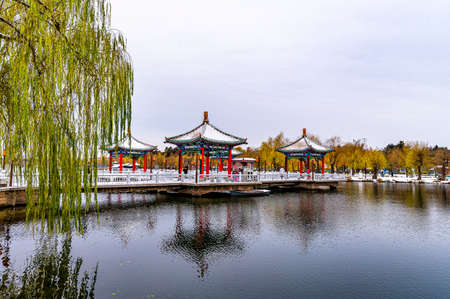Introduction to Feng Shui: Concepts and Cultural Relevance in the UK
Feng Shui, an ancient Chinese practice rooted in Taoist philosophy, has intrigued people across the globe for centuries. At its core, Feng Shui is the art of harmonising individuals with their surrounding environment through the careful arrangement of objects and spaces to optimise energy flow—known as “Qi.” Fundamental principles such as balance, orientation, and symbolism underpin this discipline. In the UK, a nation celebrated for its rich multiculturalism, Feng Shui has found a unique place within both traditional British homes and contemporary lifestyles. The assimilation of Feng Shui into British culture reflects not only a curiosity about Eastern philosophies but also a practical interest in well-being, prosperity, and environmental harmony. As a result, lucky charms associated with Feng Shui—ranging from classic symbols to modern interpretations—have become increasingly popular among those seeking to enhance luck and positive energy in their everyday lives. This article examines how these traditional and modern Feng Shui charms are perceived and utilised within the diverse context of the UK, providing insight into their evolving significance on British soil.
Overview of Traditional Feng Shui Lucky Charms
Traditional Feng Shui lucky charms have long played a significant role in Chinese culture, particularly among the Chinese diaspora in the UK. These charms are not only decorative but are also believed to channel positive energy, or “qi”, to bring about prosperity, harmony, and protection. Over generations, families have passed down both the charms themselves and the customs associated with their use. This section explores some of the most iconic traditional Feng Shui lucky charms, their symbolism, and the ways they are customarily used within British-Chinese communities.
Classic Feng Shui Lucky Charms and Their Symbolism
| Name | Symbolism | Common Use |
|---|---|---|
| Jade Ornaments | Purity, protection, health | Worn as jewellery or displayed at home entrances for good fortune |
| Chinese Coins (tied with red string) | Wealth, prosperity | Placed in wallets, tills, or offices to attract financial luck |
| Fu Dogs (Imperial Guardian Lions) | Protection against negative energies | Positioned at doorways of homes and businesses |
| Bamboo Plants | Growth, resilience, luck | Kept indoors to promote harmony and positive energy flow |
| Laughing Buddha | Happiness, abundance, good luck | Displayed in living rooms or communal spaces for uplifting atmosphere |
| Evil Eye Charms (adapted) | Ward off misfortune and jealousy | Incorporated into modern British-Chinese households as fusion décor pieces |
Traditional Methods of Use Among the UK Chinese Diaspora
The Chinese diaspora in the UK often blends classic Feng Shui practices with local British customs. For instance, while jade ornaments and coins retain their symbolic meanings, they are sometimes adapted for contemporary interiors popular in the UK. Placement is crucial: coins are commonly tied with red string—a colour symbolising luck in Chinese tradition—and hidden discreetly near doors or cash registers. Fu Dogs typically guard shop entrances in areas like London’s Chinatown.
Bamboo plants are especially favoured by younger generations seeking low-maintenance greenery that aligns with both Feng Shui principles and British tastes for indoor plants. Likewise, Laughing Buddha figurines may be placed on mantelpieces alongside other British keepsakes.
This ongoing integration of tradition demonstrates how classic Feng Shui lucky charms remain relevant for cultural identity and everyday life among British-Chinese families.

3. Modern Interpretations: Feng Shui Charms in Contemporary UK Society
In recent years, the meaning and use of Feng Shui lucky charms have evolved within the UK’s multicultural landscape. Far from being confined to traditional Chinese households, these symbols have been adopted and adapted by a wider British audience, finding their place in modern lifestyles. Today, you are just as likely to find a jade pendant or a laughing Buddha on a student’s keychain as you are in a family-run Cantonese restaurant. This shift reflects not only an interest in Eastern spirituality but also the British penchant for blending old customs with contemporary trends.
One striking example is the integration of Feng Shui motifs into fashion. British designers occasionally draw inspiration from East Asian symbolism, incorporating elements such as red thread bracelets or coin pendants into their collections. These items are marketed not merely as exotic accessories but also as meaningful tokens believed to attract positivity and balance. For many young people in the UK, wearing such charms is less about strict adherence to traditional rules and more about expressing a personal sense of optimism or well-being—sometimes even becoming conversation starters among friends and colleagues.
Home décor is another area where modern interpretations of Feng Shui are flourishing. British high street retailers now offer an array of products featuring auspicious motifs like dragons, phoenixes, or the double happiness symbol. It’s not uncommon to see small water fountains, crystal trees, or lucky bamboo plants gracing windowsills and workspaces across London, Manchester, and beyond. While some homeowners carefully position these objects according to classic Feng Shui guidelines, others simply appreciate their aesthetic appeal or the calming atmosphere they create.
Personal accessories have also become a popular way for people in the UK to carry a bit of luck with them throughout the day. From mobile phone charms shaped like golden ingots to wallets embossed with Chinese calligraphy for prosperity, these items blend cultural heritage with everyday practicality. This adaptation shows how Feng Shui beliefs are no longer restricted by ethnicity or tradition; instead, they are being reinterpreted within a uniquely British context that values both diversity and individual expression.
4. Material and Design: Contrasts Between Traditional and Modern Charms
In the UK, the evolution of Feng Shui lucky charms reflects a fascinating blend of heritage and innovation. Traditional charms often stay true to their Eastern roots, while modern alternatives adapt to British sensibilities and contemporary aesthetics. This section provides an in-depth comparison of the materials, craftsmanship, and design philosophies that distinguish these two categories.
Materials Used
| Aspect | Traditional Charms | Modern Charms (UK Market) |
|---|---|---|
| Main Materials | Natural jade, wood, bronze, silk threads | Acrylic, stainless steel, glass, synthetic fibres |
| Symbolic Elements | Hand-carved Chinese symbols, organic stones | Printed motifs, laser-engraved designs |
| Sustainability | Emphasis on natural and locally-sourced materials (in China) | Often incorporate recycled or eco-friendly components due to UK consumer trends |
Craftsmanship and Production Techniques
Traditional Feng Shui charms are typically handcrafted by artisans who employ age-old methods such as hand-knotting, carving, or calligraphy. This meticulous process imbues each piece with a sense of individuality and spiritual resonance. In contrast, modern UK-market Feng Shui charms are frequently mass-produced using automated manufacturing techniques. While this ensures affordability and consistency, it may result in the loss of personal touch found in traditional pieces.
Aesthetic Choices and Cultural Adaptation
The visual appeal of traditional charms centres on vibrant colours like red and gold—regarded in Chinese culture as auspicious—and classic motifs such as dragons or the Bagua mirror. Modern versions available in the UK often adopt subtler tones (e.g., pastel blues or minimalist silver) to better integrate with Western home décor. These updated designs might feature familiar British symbols (like the oak leaf for longevity) alongside standard Feng Shui imagery, reflecting a fusion of cultures.
User Preferences in the UK Context
The shift in material and design is also shaped by user preferences in Britain. Many UK consumers seek charms that not only bring positive energy but also serve as tasteful accessories for modern living spaces. As a result, designers are increasingly offering customisable options—such as monogrammed coins or charms themed around local landmarks—to appeal to a broader audience while maintaining Feng Shui principles.
5. Belief, Use, and Perception: How the UK Public Engages with Feng Shui Charms
Public engagement with Feng Shui lucky charms in the UK presents a fascinating landscape shaped by both curiosity and critical thought. While some individuals embrace these charms wholeheartedly, perceiving them as genuine sources of positive energy and fortune, others approach them with measured scepticism or view them simply as decorative novelties. This diversity in perception is influenced not only by personal beliefs but also by broader cultural attitudes towards superstition and alternative practices within British society.
Belief Systems and Scepticism
Among believers, there is often a willingness to integrate traditional Chinese symbols—such as coins, dragons, or crystals—into their daily lives or workspaces. These individuals may follow advice from Feng Shui consultants or online resources, aiming to harmonise their environment according to specific principles. However, there remains a significant portion of the public who regard Feng Shui charms with a degree of scepticism. For some, the practice is seen as unscientific or incompatible with rationalist values that are prevalent in UK culture. Nevertheless, even sceptics sometimes adopt charms for aesthetic reasons or as conversation pieces.
Typical Uses in Private Settings
In private homes across the UK, Feng Shui charms are most commonly found in living rooms, entryways, or bedrooms. Traditional items such as Bagua mirrors or lucky bamboo are placed to attract good fortune and deflect negative energy. Modern adaptations—like minimalist crystal arrangements or subtle metallic ornaments—are increasingly popular among younger generations who value design and symbolism equally. Placement is often guided by basic Feng Shui principles gleaned from books or websites rather than deep-rooted tradition.
Commercial and Public Spaces
The use of Feng Shui charms extends into commercial settings such as shops, restaurants, and offices. In these environments, owners may display gold ingots, laughing Buddha statues, or wealth frogs near entrances and cash registers in hopes of boosting prosperity. Here, the adoption of Feng Shui elements often serves a dual purpose: catering to an international clientele familiar with such traditions while also signalling openness to multicultural influences. Some businesses consult professional Feng Shui practitioners for more elaborate arrangements; others incorporate charms simply because “it can’t hurt.”
Cultural Integration and Social Attitudes
Overall, the integration of Feng Shui lucky charms into UK life reflects a blend of openness and pragmatism. While belief in their efficacy varies widely, these objects have found a niche through their symbolic resonance and visual appeal. The British tendency towards understatement means that overt displays are rare outside specialised venues; instead, charms are usually adopted in ways that balance personal belief with social norms. Whether viewed as tokens of luck or stylish décor, Feng Shui charms continue to offer a window into how global traditions adapt within local contexts.
6. Conclusion: The Evolving Role of Feng Shui Charms in the UK
The journey of Feng Shui lucky charms, from their traditional roots to their modern adaptations, demonstrates a remarkable capacity for cultural integration and transformation within the UK. As British society continues to diversify and embrace global influences, these charms have found new relevance—transcending their original Chinese context and becoming meaningful artefacts for many across the country. This evolution is evident in how traditional symbols like jade pendants or Chinese coins are now complemented by contemporary designs that resonate with local aesthetics and lifestyles.
The key insight from this comparison is that the enduring popularity of Feng Shui charms lies in their ability to adapt while maintaining core symbolic values. Whether displayed in homes, workplaces, or carried as personal talismans, both traditional and modern versions serve as reminders of hope, prosperity, and well-being. The British reinterpretation often blends time-honoured symbolism with subtle design cues, making these items accessible and appealing without losing their spiritual significance.
Ultimately, the ongoing transformation of Feng Shui charms in the UK reflects broader societal shifts: a willingness to experiment with cross-cultural traditions and a desire for objects that offer both aesthetic pleasure and deeper meaning. As more people seek balance in an increasingly complex world, the role of these charms will likely continue to evolve—bridging heritage and innovation, East and West, superstition and self-expression. This dynamic process not only enriches British cultural life but also ensures that Feng Shui’s ancient wisdom remains relevant for generations to come.

